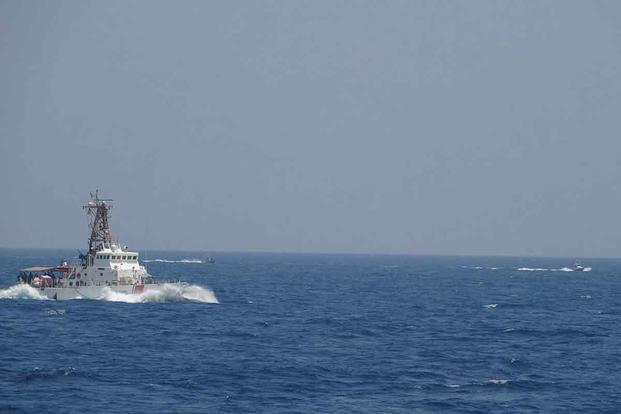A U.S. Coast Guard cutter fired warning shots from its .50-caliber machine gun at a large group of armed Iranian speedboats that were quickly approaching American ships passing through the Strait of Hormuz on Monday morning.
In a briefing with reporters, Pentagon Press Secretary John Kirby said that the group of 13 fast boats were part of Iran's Islamic Revolutionary Guard Corps Navy, or IRGCN. He called the encounter "significant."
The boats "conducted unsafe and unprofessional maneuvers, and failed to exercise due regard for the safety of U.S. forces as required under international law, while operating in close proximity to U.S. naval vessels that were transiting the Strait of Hormuz," Kirby said.
Read Next: Air Force Tests New Suits to Protect Aircrew from Biological, Chemical Attacks
The U.S. Navy said in a statement that the Iranian boats were fast in-shore attack craft, a type of speedboat that is armed with machine guns.

This represents the second time in two weeks that American ships have fired warning shots at Iranian speedboats. The Navy last month said its ships encountered Iranian speedboats on April 26 in international waters in the north Arabian Gulf and, after issuing several warnings, fired warning shots.
Six U.S. Navy and Coast Guard vessels, including the guided missile cruiser Monterey, were escorting the guided missile submarine Georgia when they encountered the Iranian ships, Kirby said, adding that the ships were on their way to the Persian Gulf.
The other American ships involved in the encounter were the Navy patrol ships Thunderbolt, Hurricane and Squall, and the Coast Guard patrol boats Maui and Wrangell.
Kirby said the Iranian boats approached the American ships at high speed, coming as close as 150 yards from them.
The Navy said that two of the 13 Iranian speedboats broke away from the larger group and moved to the opposite side of the U.S. formation. Those two speedboats approached the Maui and Squall from behind, the Navy said, at more than 32 knots, or nearly 37 miles per hour.
The Navy said the two Iranian boats had their weapons uncovered and manned. The other 11 Iranian boats remained in their original position, the service said, putting the U.S. ships between two groups of Iranian boats.
Kirby said the U.S. ships followed "all the appropriate and established procedures" and made several attempts to communicate with the Iranian boats and dissuade them from their approaches.
The Navy said that the Maui and Squall made multiple bridge-to-bridge verbal warnings, five "acoustic device" warnings, and five short horn blasts. The service said that is the internationally recognized signal for danger when trying to prevent collisions at sea.
When those efforts were unsuccessful, Kirby said, the Maui fired two volleys of warning shots from its .50-cal, totaling about 30 shots in all. The first volley was fired when the ships were within 300 yards, the Navy said, and the second when they were within 150 yards.
After the second volley of warning shots, the 13 Iranian ships broke off contact.
"The U.S. crews operated with distinct professionalism and superior seamanship," the Navy said. "As professional mariners, we expect the IRGCN to operate with due regard for the safety of all vessels as required by international law.
"Our Navy will continue to fly, sail and operate anywhere international law allows while promoting the rules-based international order throughout the region," the service continued. "In support of international norms, the U.S. is not an aggressor. Our naval forces remain postured in a non-provocative manner that exemplifies professionalism, incentives adherence to international law and customs, and persuades others to emulate our actions. Our forces are trained, however, to conduct effective defensive measures when necessary."
Kirby said he could not comment on how often such encounters have happened in the Strait of Hormuz, but added that this kind of encounter is dangerous in close quarters.
"It's an international waterway and, of course, when you're in the strait, there are certain limits to your ability to maneuver," he said. "It is a choke point in the region. So it's not insignificant that this kind of dangerous, unsafe and unprofessional behavior occurred there."
Kirby said it is not yet known whether video of this encounter exists. But videos of incidents have been released after a classification review, he said.
Kirby declined to comment on the Iranian boats' possible motivations for this encounter, or at what point U.S. ships might fire directly upon Iranian vessels.
But, he said, U.S. vessels have the right of self-defense and the means to defend themselves and their crews.
"Sadly, harassment by the IGRC Navy is not a new phenomenon," Kirby said. "It is something that all our commanding officers and crews of our vessels are trained for, when serving in the Central Command area of responsibility, particularly in and around the Gulf."
Kirby said that the two recent incidents show that American crews "are very stringent about following the proper procedures for providing warnings verbally first and then, if need be, through the use of warning shots to try to change and to mitigate the Iranian behavior."
But, he said, such behaviors are unsafe and unprofessional.
"This kind of activity is the kind of activity that can lead to somebody getting hurt, and can lead to a miscalculation in the region," Kirby said. "And that doesn't serve anybody's interests."
The Monterey recently discovered and seized an arms shipment aboard a "stateless dhow" it intercepted in the northern Arabian Sea.
That arms seizure operation, which began last Thursday and concluded Friday, netted a cache of Chinese-made Kalashnikov-style assault rifles, sniper rifles, heavy machine guns, and rocket-propelled grenade launchers.
While the Navy did not say where the shipment likely originated, similar arms caches interdicted by U.S. and other allied forces in the region were later described to be headed for Yemen.
-- Stephen Losey can be reached at stephen.losey@military.com. Follow him on Twitter @StephenLosey.
Related: US Navy Fires Warning Shots at Iranian Fast Attack Craft











